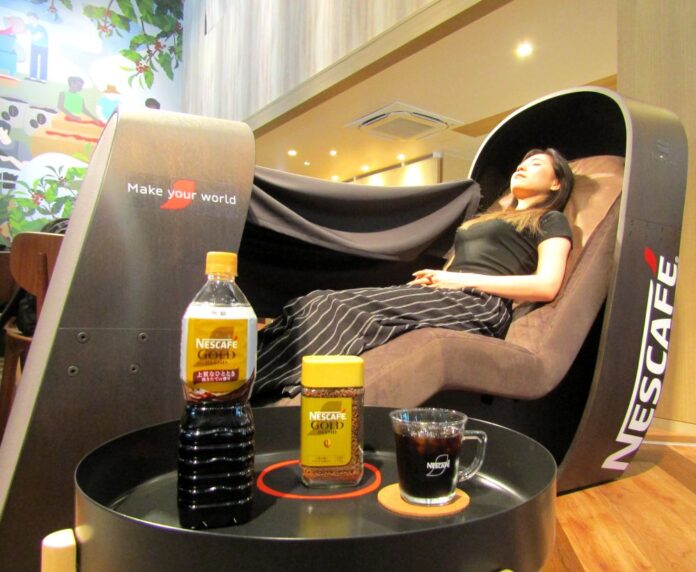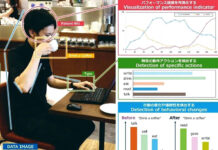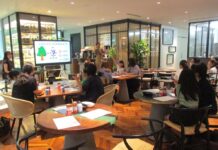It’s not “napping = slacking off”.
In order to solve the social problem of sleep deprivation among Japanese and to raise awareness of the importance of napping, Nestlé Japan and Toyota Motor Corporation have collaborated to create a high-quality nap experience.
From August 19th to December 18th, NESCAFÉ Harajuku (Shibuya-ku, Tokyo) has installed the strategic nap tool “TOTONE” developed by Toyota and jointly proposed a high-quality, short nap “coffee nap” after drinking coffee.
It is said that “power naps” are effective in recovering from brain fatigue.
Power nap means a 15 to 30-minute nap during the day time, advocated by social psychologist James Maas, and is scientifically recognized as improving cognitive ability and attention in addition to recovering from brain fatigue.
“TOTONE” is a comfortable space where you can experience high-quality power naps. Based on a special reclining chair (seat) developed by applying the seat design technology of Lexus’ high-end models, it is equipped with many functions to support comfortable falling asleep, sleeping, and awakening.
It was named by combining “TOTONOU (adjusting)” and “NERU (sleeping)”.
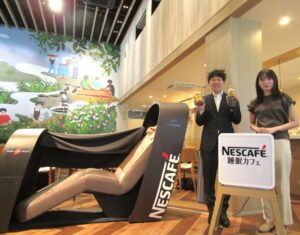
TOTONE is currently being introduced in Toyota’s offices, factories, and Lexus dealerships, as well as leased to investment and consulting companies that focus on productivity, software-related IT companies that tend to work long hours, and shared offices.
Since there are few places that can be easily used by the general public, Saaya Kato, who belongs to Toyota’s Advanced Mobility System Development Department, hopes that this collaboration with Nestlé Japan will be used by the general public and that it will foster a momentum that “it is good to take a nap”.
On the other hand, Nestlé Japan strongly promotes the coffee nap that it has been advocating for a long time in collaboration with Toyota.
On August 19, Mr. Satoshi Iwabuchi of Nestlé Japan, who attended the press conference at NESCAFÉ Harajuku with Ms. Kato, said, “We had a strong desire to popularize coffee naps. When we learned that Toyota is promoting power naps, we thought combining the two would be very interesting, so we reached out to them. It’s also fascinating that Toyota is focusing on sleep.”
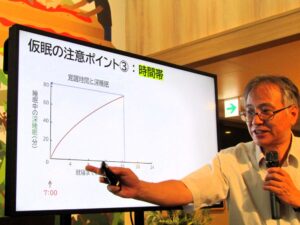
Regarding how to take a power nap, “the depth and length of the nap are important,” points out Professor Mitsuo Hayashi of the Human Science Program at the Graduate School of Human and Social Sciences, Hiroshima University.
Regarding depth, it is said that during the sleep onset period (N1: light sleep), you do not get enough sleep, and in the deep sleep period (N3: deep sleep), you sleep too much, and in the intermediate period of light sleep (N2: lack of consciousness), you can “get a refreshing feeling”, he says.
As for the length, long naps or evening naps can interfere with nighttime sleep, so napping for about 15 to 30 minutes in the early afternoon is optimal.
Coffee nap is a nap style in which you drink coffee containing caffeine before a short nap.
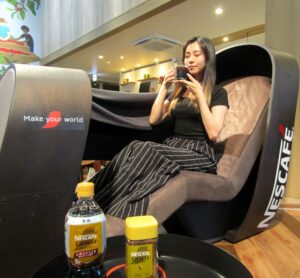
“Caffeine is absorbed from the stomach and small intestine, and in about 15 to 20 minutes after intake, the concentration of plasma reaches its maximum and caffeine takes effect,” Professor Hayashi explains.
It is ideal to get a good sleep at night to prevent drowsy driving, but Toyota believes that it is realistically difficult for everyone to ensure perfect nighttime sleep because there are many factors that affect nighttime sleep, and there are large individual differences, so Toyota is promoting power napping as a complement to nighttime sleep.
“I think that naps may be said to be ‘slacking off’, so we are now using the term strategic nap tool to appeal,” says Toyota’s Ms. Kato.
Attention and judgment are essential abilities when driving, and chronic sleep deprivation leads to a decrease in attention and judgment, which also leads to low productivity.
In 2017, Toyota held the “A-1 Contest” (a contest to determine the number one AHO (idiots)), where employees solicited volunteers and proposed ideas related to sleep. The Advanced Mobility System Development Department was launched and began leasing in February 2024.
Nestlé Japan plans to install coffee machines at companies that have introduced “TOTONE” to spread coffee naps and aims to improve satisfaction with “TOTONE”.
Mr. Iwabuchi of Nestlé Japan draws a blueprint, saying, “If we can do something like a sleep café on a business trip, we can enhance the power nap and enjoyment of coffee as well.”
According to a 2021 survey by the Organization for Economic Co-operation and Development, the average amount of time Japanese spends in sleeping in a day is 7.2 hours, the shortest among 33 countries. According to the Ministry of Health, Labour and Welfare’s 2023 National Health and Nutrition Survey, about 40% of people sleep less than 6 hours, and many people have sleep problems.

